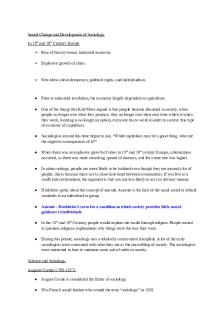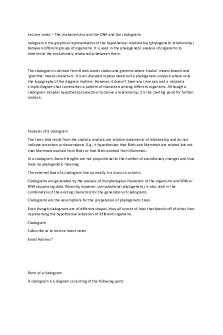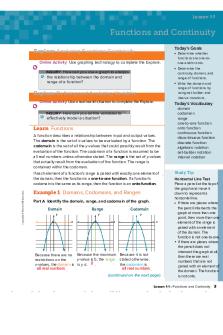HKP Lecture 7 - Histories, development and functions of the District Council and the Municipal PDF

| Title | HKP Lecture 7 - Histories, development and functions of the District Council and the Municipal |
|---|---|
| Course | Hong Kong Politics |
| Institution | The University of Hong Kong |
| Pages | 9 |
| File Size | 460 KB |
| File Type | |
| Total Downloads | 236 |
| Total Views | 601 |
Summary
Histories, development and functions of the District Council and the Municipal CouncilsFunctions of the District Council An advisory structure: o advise on matters affecting the well-being of people living in the district and those working there; o provision and use of public facilities and servic...
Description
HKP Lecture 7 Histories, development and functions of the District Council and the Municipal Councils Functions of the District Council An advisory structure: o advise on matters affecting the well-being of people living in the district and those working there; o provision and use of public facilities and services within the district; o adequacy and priorities of government programs for the district; o use of public funds allocated to the district for local public works and community activities; o undertake, where funds are made available for the purpose, minor environmental improvements within the district; and o undertake the promotion of recreational and cultural activities within the district History of the District Council 1981: White Paper on the “District Administration in Hong Kong” o Consensus politics: consultation through a complex network to achieve consensus o Kwun-tong as the first District Board 1984: Government officials no longer serve as members 1994: Abolition of appointed membership 1997-99: Provisional District Boards - all members appointed by Beijing 2004 and 2006: Reviews in the functions of the District Council 2015: Policy Address à Increase honorarium by 15% and pilot scheme Three-tier system of representation before 1997 LegCo à Municipal Councils à District Boards Municipal Councils (Norman Miners, 1986) Sanitary Board (1883) Urban Council (1935): responsibilities in the public health and hygiene fields, in the main urban areas One-third of the members were elected 1970s: The Council’s membership consisted of officials and unofficials, some appointed and others elected under a franchise extended to those who were both ratepayers and on the jurors’ list; 250,000 eligible voters, financial autonomy Regional Council (1986) Importance of the Municipal Councils (Ma Ngok, 2007) Decision-making powers in the areas of hygiene, sports, art and culture Financial autonomy and their own executive arms
HKP Lecture 7
Handle complaints from the public: Urban Council ward office o Ombudsman functions o 1973-1982: Around 10, 000 cases per year Number of voters in each constituency: around 30000-50000 Electoral College (1985), Urban/ Regional Council FC (1991)
Abolition of the Municipal Councils (2000) The Municipal Councils were replaced by an appointed Provisional Municipal Council (1st July, 1997) In December 1999, Tung Chee-wah marshaled a bill to abolish the Municipal Councils through the LegCo at the end of 2000 Disparaged the councilors for their poor handling of public health problems To replace them with new government bodies: cost-effectiveness Criticisms: Regression of democracy (elected members) Tung promised to transfer some powers of the Municipal Councils to the District Councils; pan-democrats were ambushed
Second-tier members of the Democratic Party in the Municipal Councils For examples, Lee Wing-tat and Li Wah-ming were groomed and trained in the Municipal Councils o Sapped training grounds for second-tier members o Affected the finance of the pro-democracy parties
Financial loss (ADPL 民協: tremendous loss in revenue)
Largest proportion of the directly elected members in the three-tier system Intra-party conflict in the Democratic Party Functions taken over by Food and Environmental Hygiene Department and Leisure and Cultural Services Department o Did not transfer the power to District Council as promised
Awkward situation: number of constituents
HKP Lecture 7
Demystification: The Politics of the District Council and District Management Q1: Does the District Council serve political roles? - Most people in HK think that District Councils are useless - Limited power (fighting for trivial reforms) Q2: How to compete for political influence in the districts? How to educate the district populace? - Activists from Umbrella Movement said that democratic spirits should be cultivated in the districts - Pro-china camp tried to solicit support in districts, e.g. mobilise district populace Demystifying the District Council Popular impressions of the District Council: toothless, advisory, depoliticized, disinterested o Lower voter turnout rate than LegCo elections o Unwilling to participate in DC elections even if it involves the management of district affairs which directly affects our lives More convenient for the government/ parties to do political work in the districts when the politics of the District Council is concealed? o Relationship with the government and the political system in general o Relationship with political parties and interest groups o Community activism (C1) Relationship with the government “District organizations which are not organs of political power may be established in the HKSAR, to be consulted by the government of the Region on district administration and other affairs, or to be responsible for providing services in such fields as culture, recreation and environmental sanitation” (Article 97, BL) As the BL emphasized, the District Councils are NOT political bodies o Purely an advisory body o Closely associated and controlled by the government
HKP Lecture 7
Appointed members by the Chief Executive, relations with the District Management Committee o CE can appoint 100 members (pro-China), 400 members are directly elected, ex-officio members (NT rural committees chairpersons) They are NOT independent from the government
District Management Committee A government committee consisting of officials of the core government departments in the district o Representatives from Housing Dept, Education Dept, Police, Transport Dept Chaired by the District Officer (from the Home Affairs Department), advised by the District Councils o Represented the government rather than the citizens, responsible for implementing and coordinating government policies The District Council chairman, vice chairman and chairmen of District Council committees are invited to join district management committee as members In 2015 Policy Address, the CE announced the introduction of a pilot scheme in Sham Shui Po and Yuen Long to provide the District Management Committees chaired by the District Officers with the decision-making power to tackle the management and environmental hygiene problems of some public areas o More decision-making power are granted to government-dominated DMC, but not the DC o Minor reform to the power of DC (C2) Political influence of the District Councilors in the political institutions Influence in the LegCo o 6 DC FC seats (5 new seats): Nomination and candidates by elected DC members, nomination threshold: 15 o Voting: 3.2 million registered voters who do not have a FC vote o Voters’ choice: patronage + problem solving (Stan Wong, 2015) ***would not enhance the power of DC directly, but politicized the elections at district level because the DCs have more power in nominating people into the LegCo ***Voter’s choice would be affected, in the past only powerful in the district, care about ideological commitment and the platform rather than the performance in grassroot community work? Patronage, ability, and face-to-face access in problem-solving still important in affecting voter’s choice Not all parties are benefited from DCFC addition Small parties like LSD not able to nominate people into LegCo election Influence in the CE Election Committee o Feb to Sep 2012: 59 from HK and Kowloon DCs, and 62 from NT DCs
HKP Lecture 7 o After Oct 2012: 57 from HK and Kowloon DCs, and 60 from NT DCs o Election result of the 2011 EC: Au Lok Hin not able to obtain sufficient number of votes to be admitted in the Election Committee http://www.elections.gov.hk/ecss2011/eng/results_s4.html (C3) Legitimizing government policies To show symbolic support to the government, though the effects of these political gestures may be limited Case (1) : Anti-Occupy Central Set up signing booth at the districts in opposition to OCLP movements “…. The petitioning councilors accounted for 78 percent of all members of five district councils in Kowloon. However, many of them are affiliated to political parties or organizations that were already supportive before the petition began on Saturday.” (China Daily, 22/7/2014) Case (2) : Long Mei Beach, Tai Po The government proposed to construct a 200-metre artificial beach along the coastline at Tai Po by 2015 Objections from the public: o Inaccurate description of the baseline condition of water quality o Underestimate the potential adverse ecological impact o Stream diversion will affect the organisms downstream Judicial review HKUPOP Survey on Lung Mei Artificial Beach (Dec, 2012)
The govt should leave the proposal aside
Minutes of Tai Po District Council (4th Jan, 2011) Man Chun-fai, ex-officio member of the Taipo DC (Business and Professionals Alliance for Hong Kong) said in the meeting that:
HKP Lecture 7 “他在十多年前已指出,大埔區要有酒店群才可促進區內的旅遊業發 展。發展計劃不單符合這方面的需要,也可成為地標,吸引更多旅客到 本區旅遊。大埔區一直缺乏酒店設施,要在區內為前來訪問和交流的賓 客準備住宿,十分困難。相信水療酒店落成之後,問題便會迎刃而解 … 村代表並無在會議上提出任何反對的意見。他們均期望發展計劃能配合 村民的計劃,以取得互惠互利的效果 …總括而言,在當日的會議上,大 埔鄉事委員會一致通過支持名為汀角水療度假酒店暨公共康樂用地發展 的計劃。” Tai Po Jockey Club Swimming Pool: closed due to mismanagement o
(C4) Gerrymandering The art of drawing seat boundaries/ election districts to maximize the efficiency of a party’s support By manipulating district boundaries to benefit the party and exclude competitors from the district The term comes from a constituency designed by Governor Gerry of Massachusetts in 1812 It was so long, narrow and wiggly that it reminded one observer of a salamander, hence gerrymander In the US, partisan districting has become a fine art in elections in the HOR and state legislatures, enabling the incumbents to choose their voters, rather than the other way round (Mann and Cain, 2005) 1. Since the electoral base of each district council is so small, ceding a housing estate, or even a building from a district may change the election results The size of constituency boundaries matter and hence, gives incentives for gerrymandering change the election result by ceding 1 to 2 blocks of housing 2. Then, who is in control of districting in HK? Just take a look at the homepage of the Electoral Affairs Commission (EAC) There are only 3 members in the EAC! Mr Fung Wah, Professor Fanny Cheung and Mr Arthur Luk, all of them are APPOINTED by CE, concentrated power Case (1): Report on the Recommended Constituency Boundaries for the 2011 District Council Election Only 30 days of public consultation, consultation started only 1 year before the District Council election in 2011 o No enough time to prepare for new strategies for the candidates Demarcation: Input from District Officers and various government departments such as the Planning Department, Lands Department, etc. Under Home Affairs Bureau headed by Tsang Tak-shing Any influence from political parties/ local interest groups in the process of demarcation/ drawing up the boundaries? Pro-government parties?
HKP Lecture 7
http://www.eac.gov.hk/en/distco/2011dc_boundary_v1_report.htm
Case (2): Demarcation of Nam Cheong East (Shum Shui Po District Council) 2003 DC election: Landslide victory of Leung Lai from Hong Kong Association for Democracy and People’s Livelihood 2007: Reconstruction of Shek Kip Mei Housing Estate à abolished the district Nam Cheong East Constituency was revoked by the EAC, it was divided and combined with other constituencies Leung Lai had to run for election in another constituency, Nam Cheong North, but defeated by a DAB candidate, Vincent Tse Wing-shun 2011: suggested to restore Nam Cheong East constituency, demarcation changed (Block 19, 20 are located away from the district, but served as base of votes for ADPL) (C5) Relationship with political parties and interest groups District Council as a “bridgehead” for political parties o Political training and recruitment, groom future political leaders o Parties test their popularity o Parties show their presence in the districts and establish local support o Mobilization (Mobilize voluntary workers) o Managing and coordinating resources for their political camps o District Councils have the power to allocate an earmarked government funding for community activities (they can mobilize friendly organizations to apply funding)
Example (1): Hong Kong Association for Democracy and People’s Livelihood (HKADPL) Active in Shum Shui Po District Tam Kwok-kiu, Vice-chairman of the HKADPL Ran for the LegCo election in 2012 (Kowloon West) Total number of votes: 30,634 o Shum Shui Po: 20000 votes o Yau Tsim-mong: 2000 votes Example (2): Pro-China youth organizations in the districts (Lam, 2014) Federation of New Territories Youth
HKP Lecture 7 o part of the pro-China NTAS 新界社團聯會 o Umbrella organization: 25 affiliated organizations, which include districtbased youth association, alumni associations, sports clubs, charity groups, and so on o “We have made our organization mission clear, that is, love one’s country and love HK. All applications have to be examined and approved by the Standing Committee, and we take the applicants’ ideologies very seriously….As a formal practice, the FNTY would also seek reference from ‘advisors’ that are familiar with background of the applicants.” o Closely related to the NTAS, DAB, the FTU and HYK o Current Chairman Ben Chan Han-pan, and former Chairmen Peggy Wong Pik-kiu and Gary Chan Hak-kan are appointed to the ACYF in Mainland China o There are 25 members District Councilors in the FNTY o “I was elected as a Taipo District Councilor in 2007. I was then recommended to the post of Chairman in Taipo Youth Association. Since Taipo Youth Association is one of the founding associations of the FNTY, it has a seat in the Executive Committee of the FNTY, and this is why I am in the executive position now.” Example (3): Coordination of pro-China organizations in the districts (Lam, 2014) Enables members to mobilize resources across districts and sectors Tie-up supporters/ voters across fields Example: Hong Kong Women Development Association Limited o Some may simultaneously belonged to DAB and FNTY To minimize competition between the pro-China organizations Example: Overlapping membership between DAB and FTU à to minimize conflicts between DAB and FTU, nominally increase the number of seats of DAB in the DC election (C6) Community activism: Woofer Ten Previous experiments in cultivating community activism It was formed by a group of artists in 2009, locates in Yau Ma Tei The location of Woofer Ten is actually one of the areas “saved” by the ADC from the Land Department to provide free exhibition space for autonomous art groups, subject to a renewal review every two years As opposed to an out-of-place white cube arty gallery, Woofer Ten positions itself as a social resource and more importantly, as part of a trans-national/ communal network of resistance Art is “a way of communication, a skill that is supposed to be possessed by everyone” (Lee Chun-fung, 2015)
HKP Lecture 7
“…formal art is irredeemably bourgeois not only because of the privileged possession of skills, but also its capacity to evoke special response” (Raymond Williams, 1977)
What a newcomer lacks? Umbrella neighborhood: How? District Councilors: No opportunity for promotion? Especially for career politician; not attractive for full-time, only an allowance for $20k Office space o By 2012, the DAB has 120 local offices à how to compete? o Better facilitates services, logistics support from Pro-China associations Networks o Pro-China candidates are assisted by local pro-China organizations o The constituents’ contacts o Household registration database (Stan Wong, 2015) Collected from local pro-China associations, e.g. FTU Strong network at district level...
Similar Free PDFs
Popular Institutions
- Tinajero National High School - Annex
- Politeknik Caltex Riau
- Yokohama City University
- SGT University
- University of Al-Qadisiyah
- Divine Word College of Vigan
- Techniek College Rotterdam
- Universidade de Santiago
- Universiti Teknologi MARA Cawangan Johor Kampus Pasir Gudang
- Poltekkes Kemenkes Yogyakarta
- Baguio City National High School
- Colegio san marcos
- preparatoria uno
- Centro de Bachillerato Tecnológico Industrial y de Servicios No. 107
- Dalian Maritime University
- Quang Trung Secondary School
- Colegio Tecnológico en Informática
- Corporación Regional de Educación Superior
- Grupo CEDVA
- Dar Al Uloom University
- Centro de Estudios Preuniversitarios de la Universidad Nacional de Ingeniería
- 上智大学
- Aakash International School, Nuna Majara
- San Felipe Neri Catholic School
- Kang Chiao International School - New Taipei City
- Misamis Occidental National High School
- Institución Educativa Escuela Normal Juan Ladrilleros
- Kolehiyo ng Pantukan
- Batanes State College
- Instituto Continental
- Sekolah Menengah Kejuruan Kesehatan Kaltara (Tarakan)
- Colegio de La Inmaculada Concepcion - Cebu















